Abstract
The interaction of LDL and LDL subfractions from a patient homozygous for familial defective apoB-100 (FDB) has been studied. His LDL cholesterol ranged from 2.65 to 3.34 g/liter. In cultured fibroblasts, binding, internalization, and degradation of the patient's LDL was diminished, but not completely abolished. The patient's apolipoprotein E concentration was low, and the amount of apolipoprotein E associated with LDL was not elevated over normal. LDL were separated into six subfractions: LDL-1 (1.019-1.031 kg/liter), LDL-2 (1.031-1.034 kg/liter), LDL-3 (1.034-1.037 kg/liter), LDL-4 (1.037-1.040 kg/liter), LDL-5 (1.040-1.044 kg/liter), and LDL-6 (> 1.044 kg/liter). LDL-5 and LDL-6 selectively accumulated in the patient's plasma. Concentrations of LDL-1 to 3 were normal. The LDL receptor-mediated uptake of LDL-1 and LDL-2 could not be distinguished from normal LDL. LDL-3 and LDL-4 displayed reduced uptake; LDL-5 and LDL-6 were completely defective in binding. When apolipoprotein E-containing particles were removed by immunoabsorption before preparing subfractions, LDL-3 and LDL-4, but not LDL-1 and LDL-2, retained some receptor binding activity. We conclude that in FDB, LDL-1 and LDL-2 contain sufficient apolipoprotein E to warrant normal cellular uptake. In LDL-3 and LDL-4, the defective apoB-100 itself displays some receptor binding; LDL-5 and LDL-6 are inable to interact with LDL receptors and accumulate in plasma.
Full text
PDF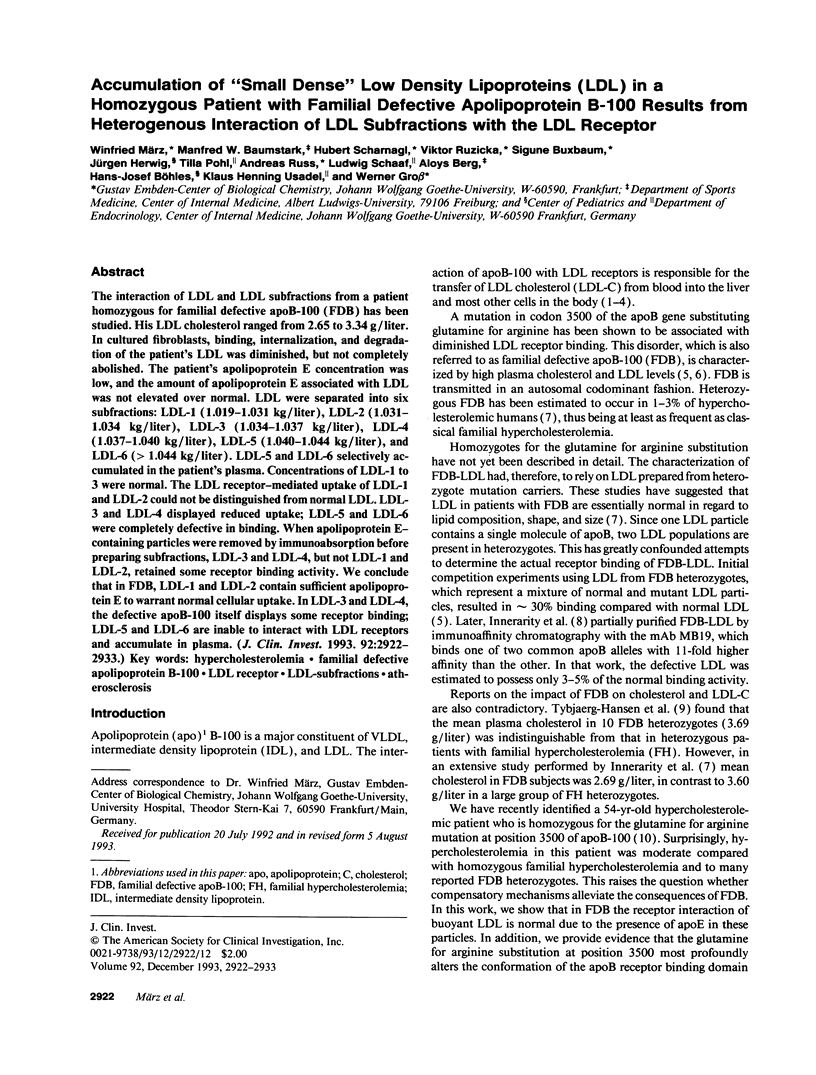
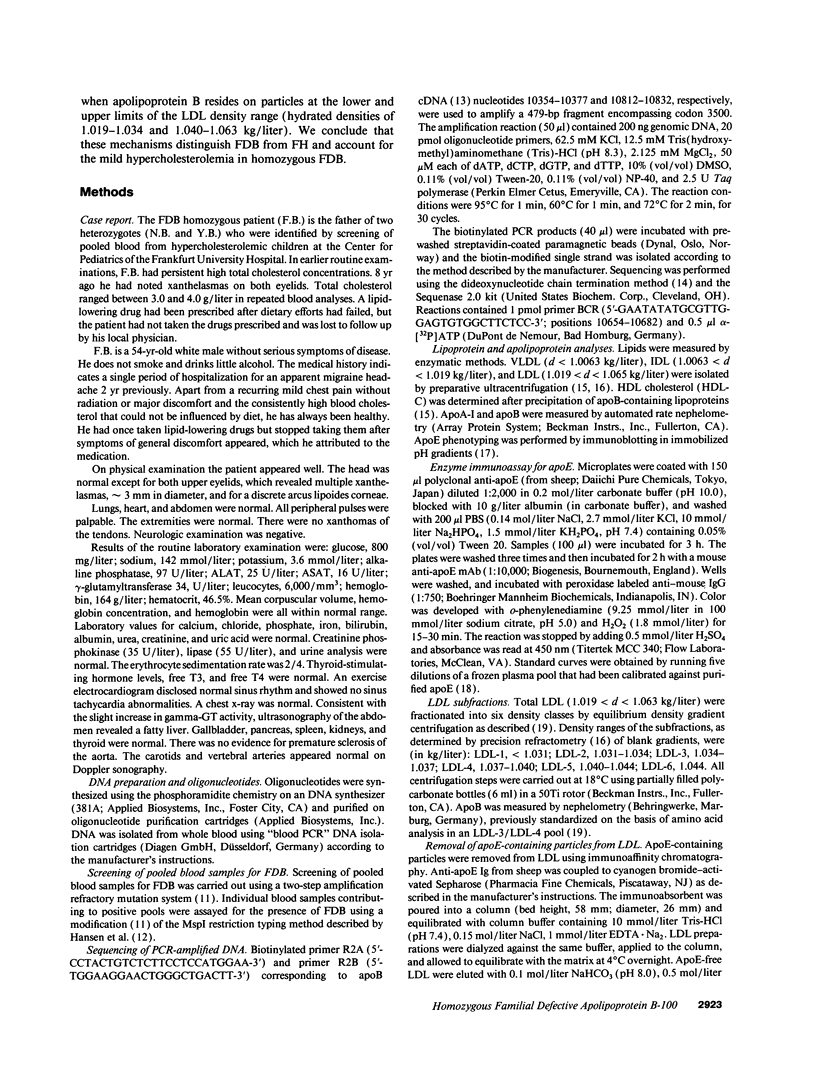
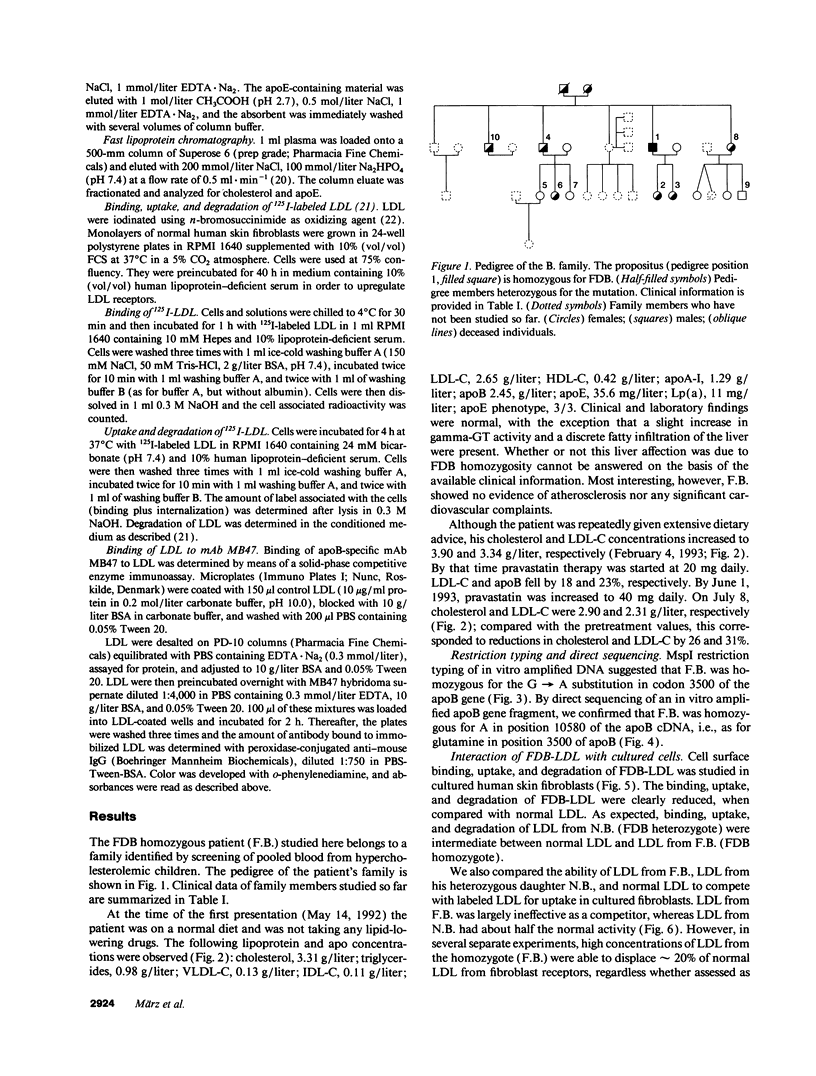
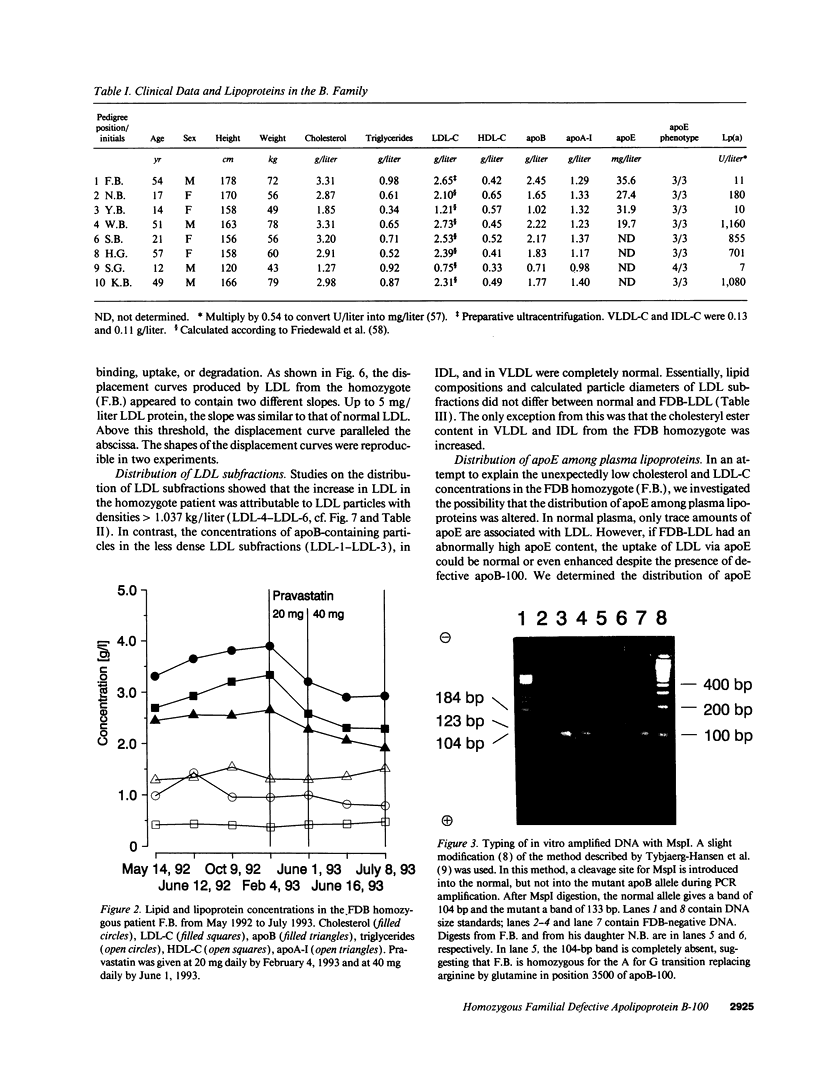
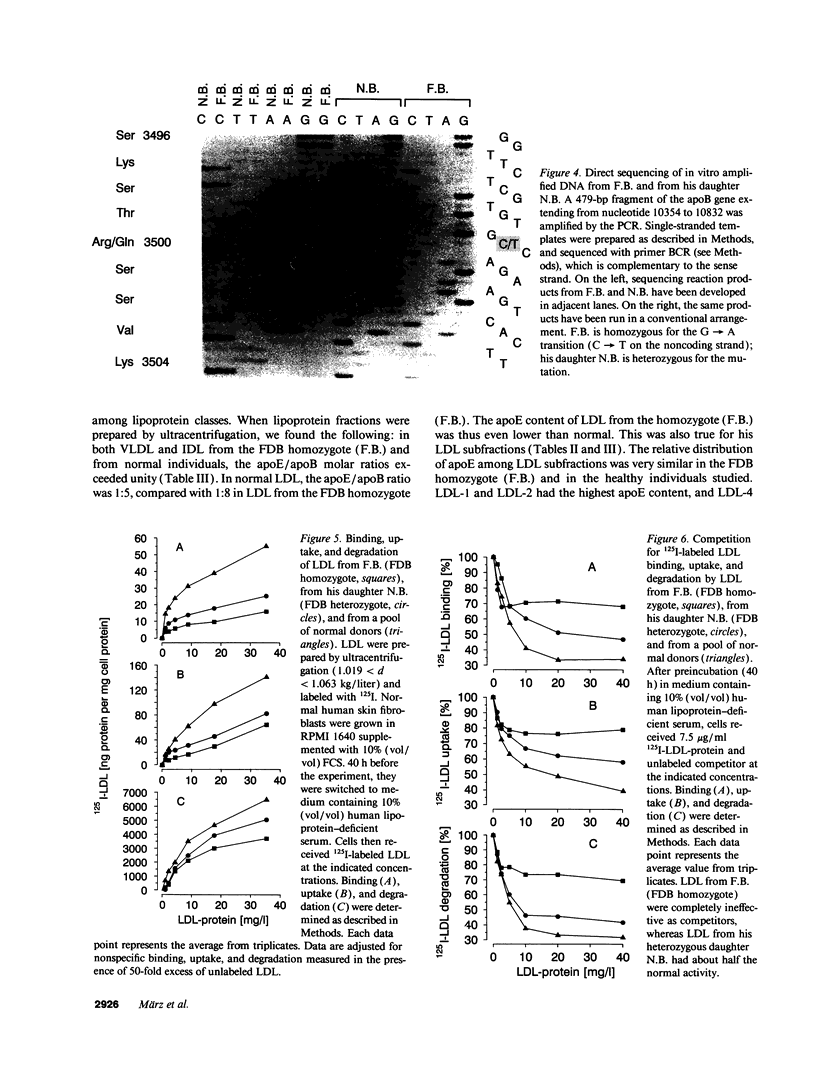




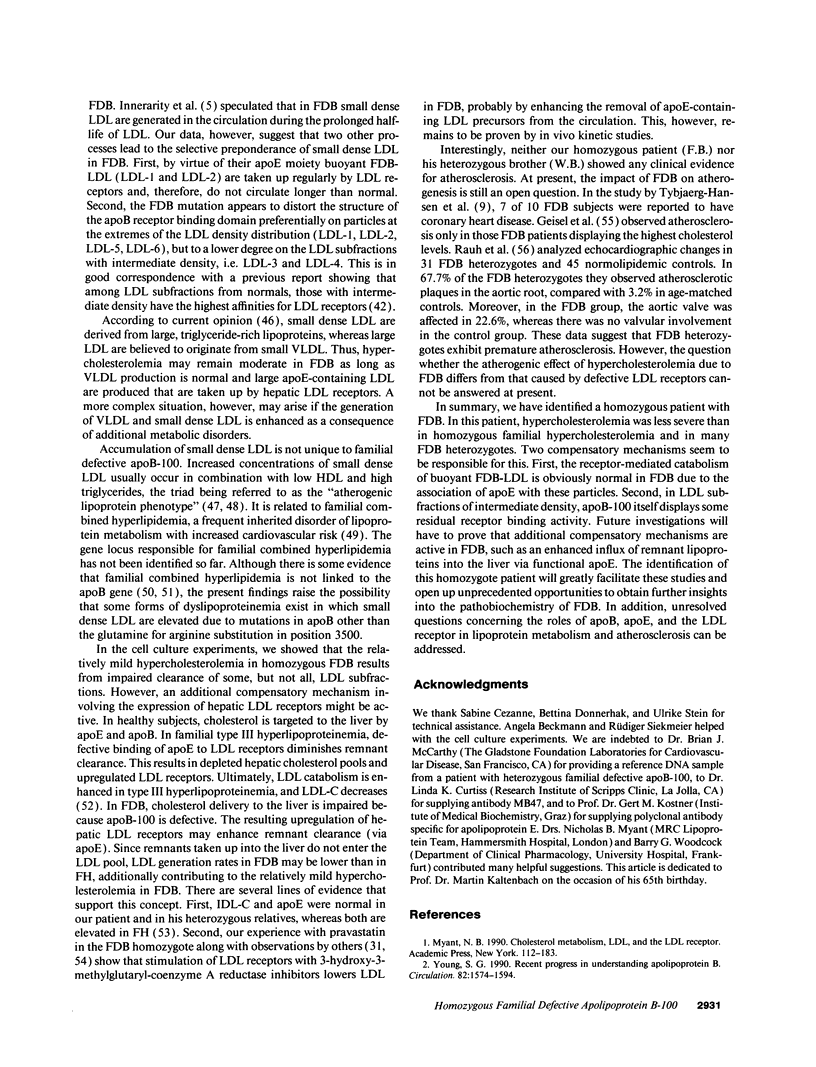
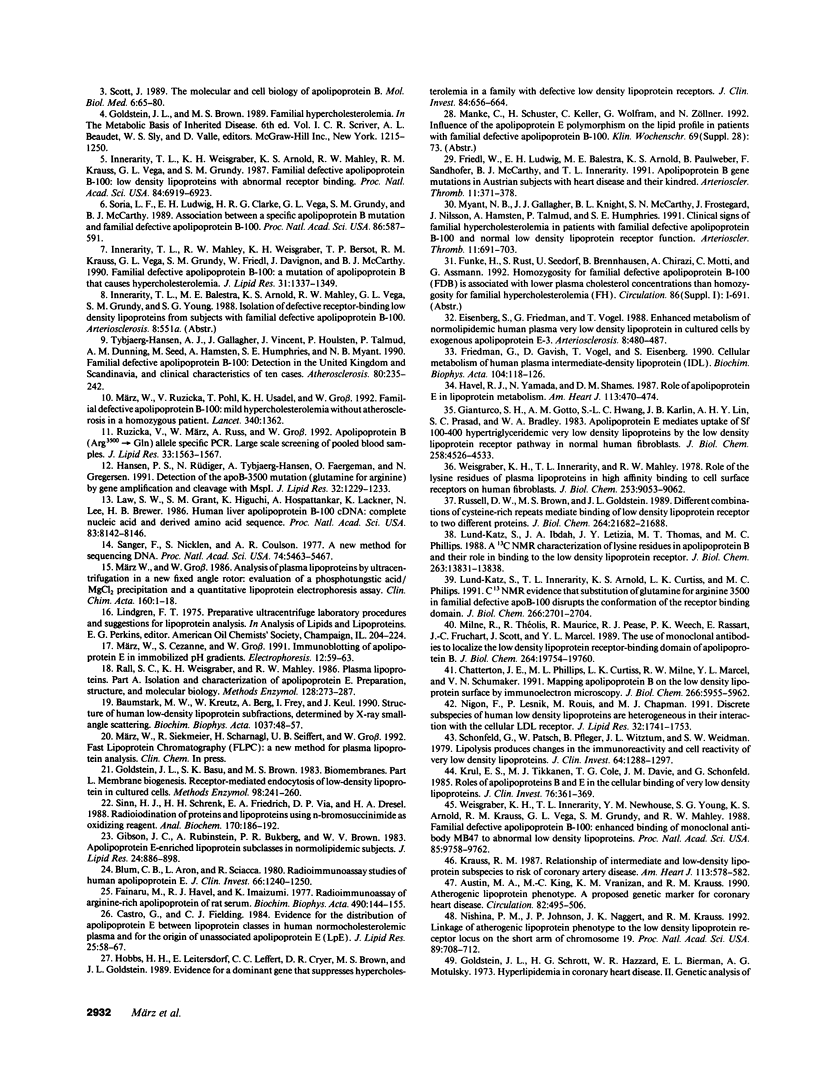
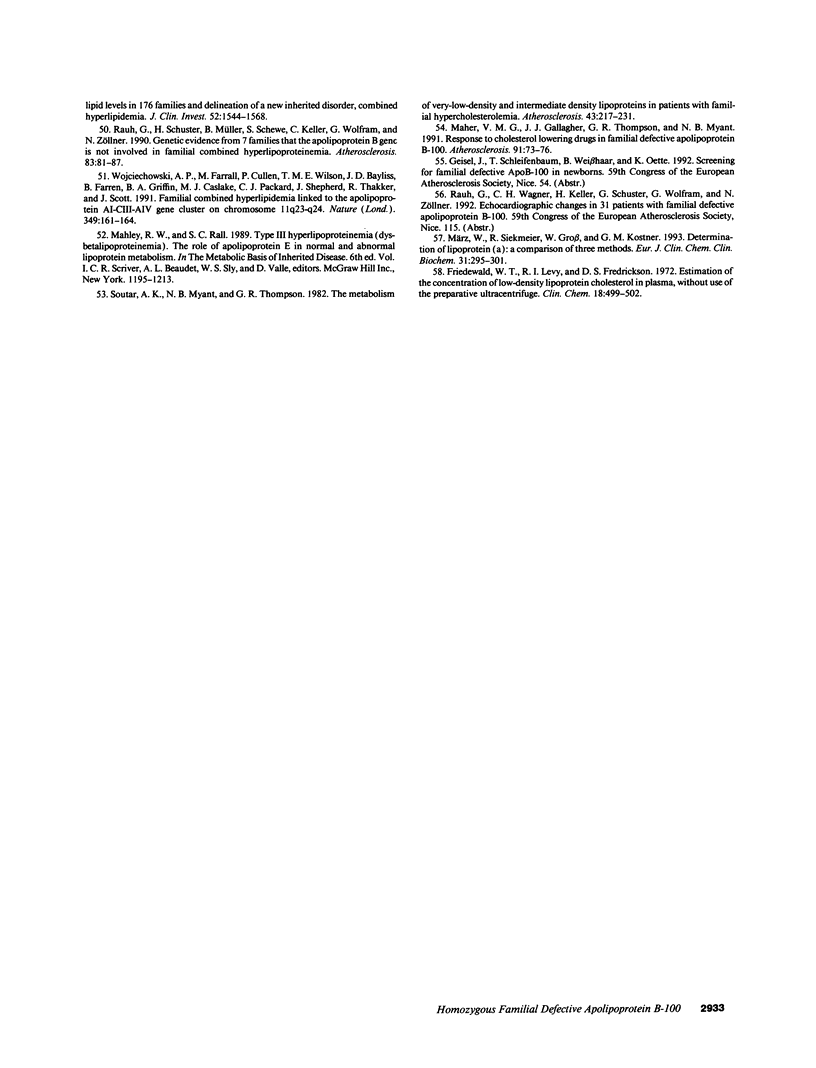
Images in this article
Selected References
These references are in PubMed. This may not be the complete list of references from this article.
- Austin M. A., King M. C., Vranizan K. M., Krauss R. M. Atherogenic lipoprotein phenotype. A proposed genetic marker for coronary heart disease risk. Circulation. 1990 Aug;82(2):495–506. doi: 10.1161/01.cir.82.2.495. [DOI] [PubMed] [Google Scholar]
- Baumstark M. W., Kreutz W., Berg A., Frey I., Keul J. Structure of human low-density lipoprotein subfractions, determined by X-ray small-angle scattering. Biochim Biophys Acta. 1990 Jan 19;1037(1):48–57. doi: 10.1016/0167-4838(90)90100-t. [DOI] [PubMed] [Google Scholar]
- Blum C. B., Aron L., Sciacca R. Radioimmunoassay studies of human apolipoprotein E. J Clin Invest. 1980 Dec;66(6):1240–1250. doi: 10.1172/JCI109975. [DOI] [PMC free article] [PubMed] [Google Scholar]
- Castro G. R., Fielding C. J. Evidence for the distribution of apolipoprotein E between lipoprotein classes in human normocholesterolemic plasma and for the origin of unassociated apolipoprotein E (Lp-E). J Lipid Res. 1984 Jan;25(1):58–67. [PubMed] [Google Scholar]
- Chatterton J. E., Phillips M. L., Curtiss L. K., Milne R. W., Marcel Y. L., Schumaker V. N. Mapping apolipoprotein B on the low density lipoprotein surface by immunoelectron microscopy. J Biol Chem. 1991 Mar 25;266(9):5955–5962. [PubMed] [Google Scholar]
- Eisenberg S., Friedman G., Vogel T. Enhanced metabolism of normolipidemic human plasma very low density lipoprotein in cultured cells by exogenous apolipoprotein E-3. Arteriosclerosis. 1988 Sep-Oct;8(5):480–487. doi: 10.1161/01.atv.8.5.480. [DOI] [PubMed] [Google Scholar]
- Fainaru M., Havel R. J., Imaizumi K. Radioimmunoassay of arginine-rich apolipoprotein of rat serum. Biochim Biophys Acta. 1977 Jan 25;490(1):144–155. doi: 10.1016/0005-2795(77)90114-3. [DOI] [PubMed] [Google Scholar]
- Friedewald W. T., Levy R. I., Fredrickson D. S. Estimation of the concentration of low-density lipoprotein cholesterol in plasma, without use of the preparative ultracentrifuge. Clin Chem. 1972 Jun;18(6):499–502. [PubMed] [Google Scholar]
- Friedl W., Ludwig E. H., Balestra M. E., Arnold K. S., Paulweber B., Sandhofer F., McCarthy B. J., Innerarity T. L. Apolipoprotein B gene mutations in Austrian subjects with heart disease and their kindred. Arterioscler Thromb. 1991 Mar-Apr;11(2):371–378. doi: 10.1161/01.atv.11.2.371. [DOI] [PubMed] [Google Scholar]
- Friedman G., Gavish D., Vogel T., Eisenberg S. Cellular metabolism of human plasma intermediate-density lipoprotein (IDL). Biochim Biophys Acta. 1990 May 1;1044(1):118–126. doi: 10.1016/0005-2760(90)90226-n. [DOI] [PubMed] [Google Scholar]
- Gianturco S. H., Gotto A. M., Jr, Hwang S. L., Karlin J. B., Lin A. H., Prasad S. C., Bradley W. A. Apolipoprotein E mediates uptake of Sf 100-400 hypertriglyceridemic very low density lipoproteins by the low density lipoprotein receptor pathway in normal human fibroblasts. J Biol Chem. 1983 Apr 10;258(7):4526–4533. [PubMed] [Google Scholar]
- Gibson J. C., Rubinstein A., Bukberg P. R., Brown W. V. Apolipoprotein E-enriched lipoprotein subclasses in normolipidemic subjects. J Lipid Res. 1983 Jul;24(7):886–898. [PubMed] [Google Scholar]
- Goldstein J. L., Basu S. K., Brown M. S. Receptor-mediated endocytosis of low-density lipoprotein in cultured cells. Methods Enzymol. 1983;98:241–260. doi: 10.1016/0076-6879(83)98152-1. [DOI] [PubMed] [Google Scholar]
- Goldstein J. L., Schrott H. G., Hazzard W. R., Bierman E. L., Motulsky A. G. Hyperlipidemia in coronary heart disease. II. Genetic analysis of lipid levels in 176 families and delineation of a new inherited disorder, combined hyperlipidemia. J Clin Invest. 1973 Jul;52(7):1544–1568. doi: 10.1172/JCI107332. [DOI] [PMC free article] [PubMed] [Google Scholar]
- Hansen P. S., Rüdiger N., Tybjaerg-Hansen A., Faergeman O., Gregersen N. Detection of the apoB-3500 mutation (glutamine for arginine) by gene amplification and cleavage with MspI. J Lipid Res. 1991 Jul;32(7):1229–1233. [PubMed] [Google Scholar]
- Havel R. J., Yamada N., Shames D. M. Role of apolipoprotein E in lipoprotein metabolism. Am Heart J. 1987 Feb;113(2 Pt 2):470–474. doi: 10.1016/0002-8703(87)90616-8. [DOI] [PubMed] [Google Scholar]
- Hobbs H. H., Leitersdorf E., Leffert C. C., Cryer D. R., Brown M. S., Goldstein J. L. Evidence for a dominant gene that suppresses hypercholesterolemia in a family with defective low density lipoprotein receptors. J Clin Invest. 1989 Aug;84(2):656–664. doi: 10.1172/JCI114212. [DOI] [PMC free article] [PubMed] [Google Scholar]
- Innerarity T. L., Mahley R. W., Weisgraber K. H., Bersot T. P., Krauss R. M., Vega G. L., Grundy S. M., Friedl W., Davignon J., McCarthy B. J. Familial defective apolipoprotein B-100: a mutation of apolipoprotein B that causes hypercholesterolemia. J Lipid Res. 1990 Aug;31(8):1337–1349. [PubMed] [Google Scholar]
- Innerarity T. L., Weisgraber K. H., Arnold K. S., Mahley R. W., Krauss R. M., Vega G. L., Grundy S. M. Familial defective apolipoprotein B-100: low density lipoproteins with abnormal receptor binding. Proc Natl Acad Sci U S A. 1987 Oct;84(19):6919–6923. doi: 10.1073/pnas.84.19.6919. [DOI] [PMC free article] [PubMed] [Google Scholar]
- Krauss R. M. Relationship of intermediate and low-density lipoprotein subspecies to risk of coronary artery disease. Am Heart J. 1987 Feb;113(2 Pt 2):578–582. doi: 10.1016/0002-8703(87)90636-3. [DOI] [PubMed] [Google Scholar]
- Krul E. S., Tikkanen M. J., Cole T. G., Davie J. M., Schonfeld G. Roles of apolipoproteins B and E in the cellular binding of very low density lipoproteins. J Clin Invest. 1985 Feb;75(2):361–369. doi: 10.1172/JCI111708. [DOI] [PMC free article] [PubMed] [Google Scholar]
- Law S. W., Grant S. M., Higuchi K., Hospattankar A., Lackner K., Lee N., Brewer H. B., Jr Human liver apolipoprotein B-100 cDNA: complete nucleic acid and derived amino acid sequence. Proc Natl Acad Sci U S A. 1986 Nov;83(21):8142–8146. doi: 10.1073/pnas.83.21.8142. [DOI] [PMC free article] [PubMed] [Google Scholar]
- Lund-Katz S., Ibdah J. A., Letizia J. Y., Thomas M. T., Phillips M. C. A 13C NMR characterization of lysine residues in apolipoprotein B and their role in binding to the low density lipoprotein receptor. J Biol Chem. 1988 Sep 25;263(27):13831–13838. [PubMed] [Google Scholar]
- Lund-Katz S., Innerarity T. L., Arnold K. S., Curtiss L. K., Phillips M. C. 13C NMR evidence that substitution of glutamine for arginine 3500 in familial defective apolipoprotein B-100 disrupts the conformation of the receptor-binding domain. J Biol Chem. 1991 Feb 15;266(5):2701–2704. [PubMed] [Google Scholar]
- Maher V. M., Gallagher J. J., Thompson G. R., Myant N. B. Response to cholesterol-lowering drugs in familial defective apolipoprotein B-100. Atherosclerosis. 1991 Nov;91(1-2):73–76. doi: 10.1016/0021-9150(91)90188-9. [DOI] [PubMed] [Google Scholar]
- Milne R., Théolis R., Jr, Maurice R., Pease R. J., Weech P. K., Rassart E., Fruchart J. C., Scott J., Marcel Y. L. The use of monoclonal antibodies to localize the low density lipoprotein receptor-binding domain of apolipoprotein B. J Biol Chem. 1989 Nov 25;264(33):19754–19760. [PubMed] [Google Scholar]
- Myant N. B., Gallagher J. J., Knight B. L., McCarthy S. N., Frostegård J., Nilsson J., Hamsten A., Talmud P., Humphries S. E. Clinical signs of familial hypercholesterolemia in patients with familial defective apolipoprotein B-100 and normal low density lipoprotein receptor function. Arterioscler Thromb. 1991 May-Jun;11(3):691–703. doi: 10.1161/01.atv.11.3.691. [DOI] [PubMed] [Google Scholar]
- März W., Cezanne S., Gross W. Phenotyping of apolipoprotein E by immunoblotting in immobilized pH gradients. Electrophoresis. 1991 Jan;12(1):59–63. doi: 10.1002/elps.1150120111. [DOI] [PubMed] [Google Scholar]
- März W., Ruzicka C., Pohl T., Usadel K. H., Gross W. Familial defective apolipoprotein B-100: mild hypercholesterolaemia without atherosclerosis in a homozygous patient. Lancet. 1992 Nov 28;340(8831):1362–1362. doi: 10.1016/0140-6736(92)92554-s. [DOI] [PubMed] [Google Scholar]
- März W., Siekmeier R., Gross W., Kostner G. M. Determination of lipoprotein(a): evaluation of three methods. Eur J Clin Chem Clin Biochem. 1993 May;31(5):295–302. doi: 10.1515/cclm.1993.31.5.295. [DOI] [PubMed] [Google Scholar]
- Nigon F., Lesnik P., Rouis M., Chapman M. J. Discrete subspecies of human low density lipoproteins are heterogeneous in their interaction with the cellular LDL receptor. J Lipid Res. 1991 Nov;32(11):1741–1753. [PubMed] [Google Scholar]
- Nishina P. M., Johnson J. P., Naggert J. K., Krauss R. M. Linkage of atherogenic lipoprotein phenotype to the low density lipoprotein receptor locus on the short arm of chromosome 19. Proc Natl Acad Sci U S A. 1992 Jan 15;89(2):708–712. doi: 10.1073/pnas.89.2.708. [DOI] [PMC free article] [PubMed] [Google Scholar]
- Rall S. C., Jr, Weisgraber K. H., Mahley R. W. Isolation and characterization of apolipoprotein E. Methods Enzymol. 1986;128:273–287. doi: 10.1016/0076-6879(86)28073-8. [DOI] [PubMed] [Google Scholar]
- Rauh G., Schuster H., Müller B., Schewe S., Keller C., Wolfram G., Zöllner N. Genetic evidence from 7 families that the apolipoprotein B gene is not involved in familial combined hyperlipidemia. Atherosclerosis. 1990 Jul;83(1):81–87. doi: 10.1016/0021-9150(90)90133-4. [DOI] [PubMed] [Google Scholar]
- Russell D. W., Brown M. S., Goldstein J. L. Different combinations of cysteine-rich repeats mediate binding of low density lipoprotein receptor to two different proteins. J Biol Chem. 1989 Dec 25;264(36):21682–21688. [PubMed] [Google Scholar]
- Ruzicka V., März W., Russ A., Gross W. Apolipoprotein B(Arg3500----Gln) allele specific polymerase chain reaction: large-scale screening of pooled blood samples. J Lipid Res. 1992 Oct;33(10):1563–1567. [PubMed] [Google Scholar]
- Sanger F., Nicklen S., Coulson A. R. DNA sequencing with chain-terminating inhibitors. Proc Natl Acad Sci U S A. 1977 Dec;74(12):5463–5467. doi: 10.1073/pnas.74.12.5463. [DOI] [PMC free article] [PubMed] [Google Scholar]
- Schonfeld G., Patsch W., Pfleger B., Witztum J. L., Weidman S. W. Lipolysis produces changes in the immunoreactivity and cell reactivity of very low density lipoproteins. J Clin Invest. 1979 Nov;64(5):1288–1297. doi: 10.1172/JCI109584. [DOI] [PMC free article] [PubMed] [Google Scholar]
- Schuler G., Hambrecht R., Schlierf G., Niebauer J., Hauer K., Neumann J., Hoberg E., Drinkmann A., Bacher F., Grunze M. Regular physical exercise and low-fat diet. Effects on progression of coronary artery disease. Circulation. 1992 Jul;86(1):1–11. doi: 10.1161/01.cir.86.1.1. [DOI] [PubMed] [Google Scholar]
- Scott J. The molecular and cell biology of apolipoprotein-B. Mol Biol Med. 1989 Feb;6(1):65–80. [PubMed] [Google Scholar]
- Sinn H. J., Schrenk H. H., Friedrich E. A., Via D. P., Dresel H. A. Radioiodination of proteins and lipoproteins using N-bromosuccinimide as oxidizing agent. Anal Biochem. 1988 Apr;170(1):186–192. doi: 10.1016/0003-2697(88)90107-8. [DOI] [PubMed] [Google Scholar]
- Soria L. F., Ludwig E. H., Clarke H. R., Vega G. L., Grundy S. M., McCarthy B. J. Association between a specific apolipoprotein B mutation and familial defective apolipoprotein B-100. Proc Natl Acad Sci U S A. 1989 Jan;86(2):587–591. doi: 10.1073/pnas.86.2.587. [DOI] [PMC free article] [PubMed] [Google Scholar]
- Soutar A. K., Myant N. B., Thompson G. R. The metabolism of very low density and intermediate density lipoproteins in patients with familial hypercholesterolaemia. Atherosclerosis. 1982 Jun;43(2-3):217–231. doi: 10.1016/0021-9150(82)90024-7. [DOI] [PubMed] [Google Scholar]
- Tybjaerg-Hansen A., Gallagher J., Vincent J., Houlston R., Talmud P., Dunning A. M., Seed M., Hamsten A., Humphries S. E., Myant N. B. Familial defective apolipoprotein B-100: detection in the United Kingdom and Scandinavia, and clinical characteristics of ten cases. Atherosclerosis. 1990 Jan;80(3):235–242. doi: 10.1016/0021-9150(90)90031-d. [DOI] [PubMed] [Google Scholar]
- Weisgraber K. H., Innerarity T. L., Mahley R. W. Role of lysine residues of plasma lipoproteins in high affinity binding to cell surface receptors on human fibroblasts. J Biol Chem. 1978 Dec 25;253(24):9053–9062. [PubMed] [Google Scholar]
- Weisgraber K. H., Innerarity T. L., Newhouse Y. M., Young S. G., Arnold K. S., Krauss R. M., Vega G. L., Grundy S. M., Mahley R. W. Familial defective apolipoprotein B-100: enhanced binding of monoclonal antibody MB47 to abnormal low density lipoproteins. Proc Natl Acad Sci U S A. 1988 Dec;85(24):9758–9762. doi: 10.1073/pnas.85.24.9758. [DOI] [PMC free article] [PubMed] [Google Scholar]
- Wojciechowski A. P., Farrall M., Cullen P., Wilson T. M., Bayliss J. D., Farren B., Griffin B. A., Caslake M. J., Packard C. J., Shepherd J. Familial combined hyperlipidaemia linked to the apolipoprotein AI-CII-AIV gene cluster on chromosome 11q23-q24. Nature. 1991 Jan 10;349(6305):161–164. doi: 10.1038/349161a0. [DOI] [PubMed] [Google Scholar]
- Young S. G. Recent progress in understanding apolipoprotein B. Circulation. 1990 Nov;82(5):1574–1594. doi: 10.1161/01.cir.82.5.1574. [DOI] [PubMed] [Google Scholar]




